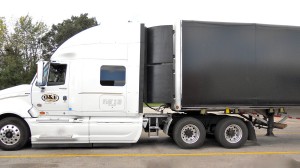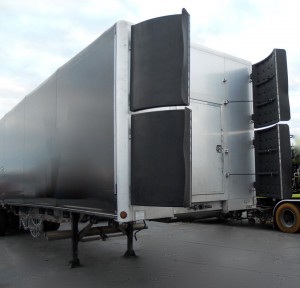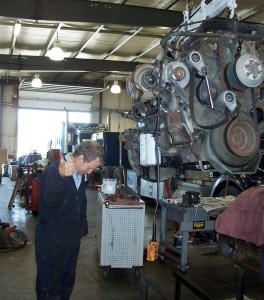 The 2008 Caterpillar nightmare is finally over for one owner operator! In 2007, I received a phone call from an owner operator stating that he was buying his dream truck – a new 2008 Peterbilt with a 600 hp Cat SDP engine. The SDP is the serial number of Cat’s final highway engine. The SDP is a C-15 ACERT that is equipped with Cat’s DPF. I begged him not to buy it, however he already had it on order and was going to take delivery of it soon. And soon after he took delivery, the problems began.
The 2008 Caterpillar nightmare is finally over for one owner operator! In 2007, I received a phone call from an owner operator stating that he was buying his dream truck – a new 2008 Peterbilt with a 600 hp Cat SDP engine. The SDP is the serial number of Cat’s final highway engine. The SDP is a C-15 ACERT that is equipped with Cat’s DPF. I begged him not to buy it, however he already had it on order and was going to take delivery of it soon. And soon after he took delivery, the problems began.
On the truck’s very first trip, from New Jersey to California, the SDP Caterpillar broke down 28 times and had to be towed 10 times. During the next three and a half years, the owner of this truck was only able to drive it for a total of 202,000 miles because of the constant downtime due to breakdowns. There were times this truck sat in a Peterbilt or Caterpillar shop for over three weeks at a time because they did not know how to keep it running. The owner’s dispatcher would no longer load him with any kind of time-sensitive freight because he knew he could never make it to the destination without a breakdown. But, the story gets worse.
The owner of this SDP Caterpillar-powered Peterbilt has a book filled with repair records and breakdowns that is several inches thick. Due to this SDP owner’s downtime he is flat broke, and if it wasn’t for personal loans from the owner of the company he is leased to he would have lost his truck and his home. He has two teenage boys – what do you do with teenagers when you’re homeless? It was not a pretty situation.
It might seem like I am blaming Cat for the problems this SDP has, but I am not (and nether is the owner of this rig). These issues were not caused by Caterpillar – they know how to build great engines. These problems are from the rules that Caterpillar has been forced to follow to meet the EPA’s requirements for emissions. We all know that these EGR and ACERT systems, DPFs and everything else they have to hang on these new engines is literally killing the trucking industry – and will eventually kill our country, if we are not careful. Think about the parts and labor costs of a truck that spends a quarter of its life in a shop during its warranty period. Who do you think will ultimately pay for all of it? You guessed it – you, the customer!
The cost of parts for 2003 and newer engines has skyrocketed, along with warranty claims. The engine manufacturers pass the costs of all these warranty claims to you by raising the price of the parts. Not only do owner operators lose fuel mileage because of EGR, DPF, ACERT and other items harming the engine’s efficiency, but they also have to pay more for engine parts. In my opinion, having a truck newer than 2002 is a no win situation. My calculations show that you are losing at least $12,000 per year – and that, my friend, is a very conservative figure.
 The Cat SDP-powered 2008 Peterbilt we are talking about here was originally producing 4.2 mpg and had already burned approximately 2,000 gallons of fuel over its short life just sitting alongside the highway during its regen cycles. So, $8,000 worth of fuel was burned just to clean the DPF (and this was while the truck wasn’t even moving). The owner of this truck finally got disgusted and did some major upgrades and during the first trip the fuel mileage jumped to 6.2 mpg. Unfortunately, this truck is equipped with 3:36 gears, the absolute worst setup for fuel mileage. I told him about this limitation and the best way to deal with it (basically, use the turbo boost gauge and slow down). The best way to drive with 3:36 gears is to split out of 18th gear and pull most of the big hills in 17th, even though this Cat now has the power to stay in 18th. With today’s 13- and 18-speed transmissions, you don’t get to direct until you drop two gears, and direct gear is the most efficient gear for pulling, so drop to 16th (or 11th) when possible.
The Cat SDP-powered 2008 Peterbilt we are talking about here was originally producing 4.2 mpg and had already burned approximately 2,000 gallons of fuel over its short life just sitting alongside the highway during its regen cycles. So, $8,000 worth of fuel was burned just to clean the DPF (and this was while the truck wasn’t even moving). The owner of this truck finally got disgusted and did some major upgrades and during the first trip the fuel mileage jumped to 6.2 mpg. Unfortunately, this truck is equipped with 3:36 gears, the absolute worst setup for fuel mileage. I told him about this limitation and the best way to deal with it (basically, use the turbo boost gauge and slow down). The best way to drive with 3:36 gears is to split out of 18th gear and pull most of the big hills in 17th, even though this Cat now has the power to stay in 18th. With today’s 13- and 18-speed transmissions, you don’t get to direct until you drop two gears, and direct gear is the most efficient gear for pulling, so drop to 16th (or 11th) when possible.
This Peterbilt is now getting in the low 7 mpg range and no longer has the reliability problems it had before. If the owner of this Peterbilt can log the fleet average of 125,000 miles per year and get 7.3 mpg he will save $50,555 next year. So, ask yourself what is better for the environment – a factory SDP Caterpillar engine getting 4.2 mpg using 29,761 gallons of fuel per year or a modified and upgraded engine getting 7.3 mpg using 17,123 gallons each year? The exhaust may be cleaner, but at what price? The bottom line: don’t lose hope or give up – make the necessary changes and fix the problems before they ruin you and your profitability!
Caterpillar is not the only manufacturer with problems. We recently had an owner operator in our shop that had so much trouble with his Detroit DDEC-V EGR engine that he ended up replacing it with a new DDEC-IV engine. The DDEC-V had worn out its camshaft by the time it had 131,000 miles on it, and at 243,000 the cylinder liners were scored due to soot from the EGR system. At 287,000 miles, the cylinder liners were scored again due to soot, and the cylinder block had to have the counter bores cut. Now, a lawyer is involved and the head chemist at Mobil Oil is calling me to discuss the lawsuit. As the chemist put it, “A dog can only live so long eating its own waste.” This is a disgusting but true statement!
The last rebuild Detroit did on this failing DDEC-V engine only lasted 44,000 miles and this repair was not covered under the warranty so the customer had to pay $13,000. During the life of the engine, this DDEC-V has had five EGR valves replaced (three of which the customer had to pay for), a VG turbo, an EGR delta pressure sensor, a charge air cooler, a crank sensor, a clutch fan and nine alternators. This engine gets its oil changed every 15,000 miles and has a bypass oil filter installed.
Today, the DDEC-V engine has 569,000 miles on it and it’s worn out again. The owner operator of this fine truck is also a farmer and has been around machinery his entire life – he is very meticulous. His truck, as well as all of his John Deere equipment, is always expertly maintained and wiped down every night. He told me, “This engine has got to go. I can no longer afford it and can’t tolerate it any more.” In one of the photos you see here, his DDEC-V EGR engine is hanging from the hoist as we remove it. By the time you read this, his troubles will finally be over.
 For years I have wanted to develop a good way to connect the back of the sleeper with the trailer to eliminate crosswinds from getting caught in front of the trailer and causing excessive drag. Finding the time to develop things like this is difficult for me. Often, I depend on the ingenuity of owner operators (over the years they have taught me much). A few months ago we had the privilege of meeting a creative owner operator by the name of Tim Kenevan. Tim needed a truck in a hurry and let a salesmen talk him into buying a new International with their new Max Force engine. Tilting the hood, you can’t even see the engine because it has so much BS hanging on it. This fifteen month old truck has already spent three months in the shop. That’s one day in the shop for every five days on the road. I understand that this thing makes so much heat from its aggressive EGR system that it has four coolers buried somewhere in that engine compartment. Does it get the fuel mileage promised? Nope! Sorry, there is none to be had there. However, Tim’s new invention does help his truck make better fuel mileage.
For years I have wanted to develop a good way to connect the back of the sleeper with the trailer to eliminate crosswinds from getting caught in front of the trailer and causing excessive drag. Finding the time to develop things like this is difficult for me. Often, I depend on the ingenuity of owner operators (over the years they have taught me much). A few months ago we had the privilege of meeting a creative owner operator by the name of Tim Kenevan. Tim needed a truck in a hurry and let a salesmen talk him into buying a new International with their new Max Force engine. Tilting the hood, you can’t even see the engine because it has so much BS hanging on it. This fifteen month old truck has already spent three months in the shop. That’s one day in the shop for every five days on the road. I understand that this thing makes so much heat from its aggressive EGR system that it has four coolers buried somewhere in that engine compartment. Does it get the fuel mileage promised? Nope! Sorry, there is none to be had there. However, Tim’s new invention does help his truck make better fuel mileage.
Tim is a thinker – he used to be a nuclear power engineer in the Navy. His love of trucking proved too strong to resist and after his naval career ended he purchased his first truck in 1977. His invention, called “The Cross Wind Blocker,” is the result of a joint effort between Tim and a project engineer from John Deere. This product was very well engineered and is manufactured of rotational molded plastic. Once “The Cross Wind Blocker” panels are mounted to the front of the trailer, using stainless steel and aluminum mounting hardware, the system is fully adjustable and can be removed or repositioned with the pull of just one pin per panel. These panels are hardly noticeable on Tim’s truck, but he has gained 1/2 mpg (and sometimes more) since installing them.
Joe Lambright, who is leased to Long Hall Trucking, owns a W900-L Kenworth powered by a C-16 Cat with 600 hp. Joe pulls a Benson flatbed with a roll tarp and has a 60” gap between the front of the trailer and the back of the bunk. Once Joe installed “The Cross Wind Blocker” his truck’s efficiency has gained over 1 mpg. Wind can only jump a 36” gap between the back of the bunk and the front of the trailer, so with a 60” gap, he was pulling a lot of wind along with him as he rolled down the road. “The Cross Wind Blocker” is fully adjustable and can fit any truck, so even if you pull a company trailer that has the system installed, you will be able to adjust it to fit your truck in about 90 seconds. We at Pittsburgh Power are proud to be a distributor of this functional new product. If you have any questions, you can call us or you can call Tim, the inventor, at (509) 675-8244.
On a final note, a few months ago I began planning an owner operator motorcycle ride. Details on the “Wing Ride” are now coming together. The three day ride will start at 7:00 AM on Friday, September 23rd at our shop in Saxonburg, PA. From there, we will be taking Route 28 north to Brookville, then pick up Route 36 to Marienville, then Route 66 to Mt. Jewett. After that, we will be traveling north on 219 into New York, and 417 into Salamanca. Then, we will head to Springville, NY to tour the Vibratech TVD facility to see how crankshaft dampers are made and why they need to be changed every 500,000 miles. While in Springville, we will also tour the Jaybrake Motorcycle Parts facility. Friday evening we plan on eating at the Anchor Bar (where the Buffalo wing was invented) and then going to two more bars specializing in chicken wings. On Saturday morning, we will be heading to Niagara Falls for the day and then back to Pittsburgh on Sunday. If you would like more information about the ride, contact me at Pittsburgh Power in Saxonburg, PA at (724) 360-4080 or via e-mail at bruce@pittsburghpower.com.

1 Comment
Hey bruce how are you doing i recently puchased a 2010 w900l with a c15 acert sdp can u tell me wat were the upgrades that the peterbilt owner did i have my horsepowet set at 550 and i also run a 18spd with 355 rears